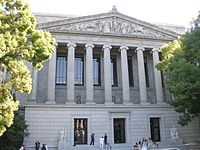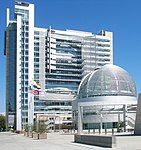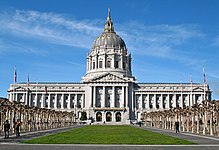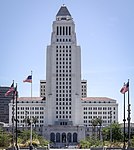Government of California
 |
|---|
The government of California is the governmental structure of the
Executive branch
California's elected executive officers are:
-
Attorney General

All offices are elected separately to concurrent four-year terms, and each officer may be elected to an office a maximum of two times.
State agencies



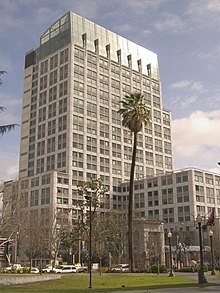
State government is organized into many departments, of which most have been grouped together into several huge Cabinet-level agencies since the administration of Governor Pat Brown. These agencies are sometimes informally referred to as superagencies, especially by government officials, to distinguish them from the general usage of the term "government agency".[7][8] When Brown took office, he was dismayed to discover that under California law, approximately 360 boards, commissions, and agencies all reported directly to the governor, and proposed his "super-agency" plan (then spelled with a hyphen) in February 1961 to impose order on such chaos.[9] Brown appointed the secretaries of the first four superagencies (of eight then planned) in September 1961.[10]
The superagencies operate as "umbrella organizations"[7] or "semiautonomous fiefdoms," but their Cabinet-level secretaries are not quite as powerful as they may appear at first glance.[11] The governor continues to directly appoint the leaders of superagency components. The appointments are announced by the governor rather than by the secretaries, who are merely a layer of management installed to ensure that the components of their respective superagencies can stay outside of the governor's "routine attention span" (unless something goes wrong).[11] Today, the Cabinet-level agencies (superagencies) are the:[12]
- California Business, Consumer Services and Housing Agency (BCSH)
- California Government Operations Agency (CalGovOps)
- California Environmental Protection Agency (CalEPA)
- California Health and Human Services Agency (CalHHS)
- California Labor and Workforce Development Agency (LWDA)
- California Natural Resources Agency (CNRA)
- California State Transportation Agency (CalSTA)
The independently elected officers run separate departments not grouped within the superagencies, and there are other Cabinet-level departments:
- Department of Corrections and Rehabilitation (CDCR)
- Department of Education (CDE)
- Department of Finance (DOF)
- Department of Food and Agriculture (CDFA)
- Department of Insurance (CDI)
- Department of Justice (DOJ)
- Military Department
Independent entities
Most (but not all) of the leaders of these entities are normally appointed by the governor and confirmed by the state Senate. Despite their independence, the governor can exert influence on them over time by waiting for incumbent leaders to reach the ends of their terms and appointing new ones who support the governor's current agenda.[13]
Examples include the:
- Regents of the University of California
- California State University Board of Trustees
- California Community Colleges Board of Governors
- California Public Utilities Commission
- California State Auditor
- Fair Political Practices Commission
Legislative branch
The California State Legislature is the state legislature. It is a
The speaker of the California State Assembly presides over the State Assembly. The lieutenant governor is the ex officio president of the Senate and may break a tied vote, and the president pro tempore of the California State Senate is elected by the majority party caucus.
The Legislature meets in the California State Capitol in Sacramento. Its session laws are published in the California Statutes and codified into the 29 California Codes.
Judicial branch
The judiciary of California interprets and applies the law, and is defined under the Constitution, law, and regulations. The judiciary has a hierarchical structure with the Supreme Court at the apex. The superior courts are the primary trial courts, and the courts of appeal are the primary appellate courts.
The Judicial Council is the rule-making arm of the judiciary.[15][16]
The California Supreme Court consists of the
The California superior courts are the courts of
Direct democracy
The state also allows direct participation of the electorate by initiative, referendum, and recall.
Watchdog evaluations
In a 2015 review by the nonprofit
In 2005, Pew Research Center's Government Performance Project gave California a grade C−, tied for last with Alabama.[22] By 2008, when the last report was issued, California had a C, which placed it near the bottom of the states.[23] In discussing the results, the report noted that the personnel system is known to be dysfunctional, and that the Human Resources Modernization Project was underway to address the issue.[24]
Local government
California is divided into counties which are legal subdivisions of the state.
- City halls in California
-
San José City Hall
See also
References
- ^ Alfieri, Joe (18 October 2010). "Jerry Brown defies intent of California term limits". Contra Costa County Conservative Examiner. Examiner.com.
- ^ Constitution of California, article 5, section 2
- ABC-CLIO.
- ^ In re Governorship, 26 Cal.3d 110, 401 (Supreme Court of California 1979) ("we conclude that the Lieutenant Governor has authority to exercise all gubernatorial powers of appointment while the Governor is physically absent from the state and that the Governor has authority to withdraw the appointment until the confirmation of appointment becomes effective.").
- ^ "Overview, Board of Trustees". California State University. Archived from the original on 1 February 2010. Retrieved 15 June 2011.
- ISBN 978-1-862-87723-8.
- ^ ISBN 9781452203065. Retrieved 25 February 2019.
- ISBN 9781538129302.
- ^ Blanchard, Robert (February 14, 1961). "Brown Criticized for His Super-Agency Proposal". Los Angeles Times. p. 1. Available through ProQuest Historical Newspapers.
- ^ Gillam, Jerry (October 1, 1961). "Brown Picks 8-Member Cabinet: Four Named to Head New State Super-Agencies". Los Angeles Times. p. 1. Available through ProQuest Historical Newspapers.
- ^ ISBN 9781538129302.
- ^ "Governor Brown's Government Reorganization Plan Becomes Law". Office of the Governor of California. 3 July 2012. Archived from the original on 18 October 2012. Retrieved 26 July 2012.
- ISBN 9780520925014. Retrieved 3 July 2020.
- ^ a b Constitution of California, article 4, section 2(a)
- ^ Constitution of California, Article 6, Section 6(d)
- ^ "Judicial Council". Judicial Council of California.
- ^ Constitution of California, Article 6, § 3
- California Government Code§ 69100
- ^ Auto Equity Sales, Inc. v. Superior Court,, 57 Cal. 2d 450, 369 P.2d 937, 20 Cal. Rptr. 321 (1962).
- ^ Constitution of California, Article 6, § 4
- ^ a b "California gets C- grade in 2015 State Integrity Investigation". Center for Public Integrity. 2015-11-09. Retrieved 2016-12-05.
- ^ "State civil service reform: California's Human Resource Modernization project in a comparative perspective - SEIU Local 1000". www.seiu1000.org. Retrieved 2016-12-04.
- ^ Johnson, Neal. "NLPES/NALFO Seminar Madison, Wisconsin September 26, 2008" (PDF). Pew Center on States.
- ^ "Grading the States 2008: Pew's 50-State Report Card Evaluates How States Manage Public Resources". www.pewtrusts.org. Retrieved 2016-12-05.
- ^ Constitution of California, article 11, section 1
- ^ "Learn About Cities". League of California Cities. Retrieved 13 March 2014.
- ^ a b Individual State Descriptions: 2007 (PDF), 2007 Census of Governments, United States Census Bureau, November 2012, pp. 25–26
- ^ Mizany, Kimia; Manatt, April. What's So Special About Special Districts? A Citizen's Guide to Special Districts in California (PDF) (3 ed.). California Senate Local Government Committee. Archived from the original (PDF) on 2011-07-04. Retrieved 2008-12-09.
- California Government Code§§ 25132, 36900 et seq.
- California Government Code§ 16271(d)










